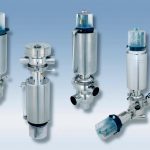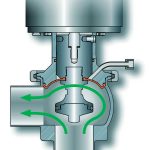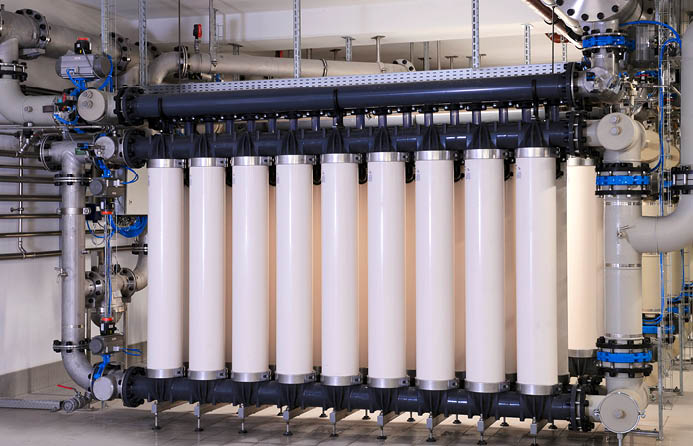Das Gembra-Aseptikventilprogramm vereinigt die Vorteile der guten Reinigbarkeit einer sicheren und langlebigen Membrandichtung mit den geometrischen Vorteilen der Sitzventiltechnik in Bezug auf Totraumfreiheit und Leerlaufverhalten. Es eignet sich gleichermaßen für pharmazeutische und lebensmitteltechnische Anwendungen. The Gembra aseptic valve programme combines the advantages of good cleanability of a reliable and long-lasting diaphragm sealing with the geometric advantages of the seat valve technology in respect of no clearance volume and drainability. It is likewise suitable for pharmaceutical and food related applications.
Daniel Heinze
An das Produktionsequipment, vor allem an die Ventiltechnik, werden in der Pharma- und Lebensmittelindustrie hohe Anforderungen gestellt. Die Anwender wollen eine sichere, standfeste Sterildichtung, die einfach zu reinigen, druck-, vakuum-, strömungs- und temperaturfest ist und zusätzlich noch einen wirtschaftlichen Betrieb ermöglicht.
Kieselmann bietet daher mit dem Gembra-Ventil ein aseptisches Ventil mit einer Sinus-Membrandichtung aus dem Dichtungswerkstoff k-flex. Das Ventilkonzept greift dabei auf eine bewährte Dichtungstechnologie zurück. K-flex ist ein nahezu universell einsetzbares PTFE-Compound mit dem Rückstellverhalten eines Elastomers und ist seit vielen Jahren sehr erfolgreich in den Doppelsitzventilen von Kieselmann im Einsatz. Es hat sich in vielen Anwendungen als außerordentlich flexibel und resistent bewährt und weist selbst unter Sterilbedingungen ausgezeichnete mechanische Eigenschaften auf. Die Sinus-Membrandichtung aus diesem Werkstoff widersteht den mechanischen Belastungen der heutigen Prozesse mühelos.
Klassische Membranventile werden an der Membraneinspannung auf Quetschung beansprucht, in der Membranfläche auf Zug und Druck und am Dichtsteg wiederum auf Quetschung. Die Folge ist eine Überlagerung verschiedener Kräfte in der Membran, was zur Überlastung und zum Ausfall führt. Ganz anders bei der aseptischen Ventilreihe Gembra. Die Membran wird im Gehäuse und an der Ventilstange in einer O-Ring-Nut sicher und fest gehalten. Eine exakt definierte, materialschonende Bewegung sowie der metallische Anschlag in allen Bauteilen verhindert wirkungsvoll die mechanische Überlastung der Membran und aller weiteren Dichtungselemente.
Balgventile müssen oft in zwei Richtungen gereinigt werden, da auf der Rückseite des Balges ein Spülschatten entsteht, in dem sich Keime und Produktreste halten. Die Dichtmembran der Gembra-Aseptikventile ist absolut eben und schließt, wie die innere Wandung des Edelstahlgehäuses, die Strömung ein. Sie wird als Teil der Gehäusehaut wie die Rohrwandung von der strömenden Flüssigkeit gereinigt. Der k-flex-Dichtungswerkstoff bietet dabei umfassenden Schutz gegen einen chemischen Angriff durch Reinigungsmittel und Produktbestandteile und ermöglicht so eine bis zu 2,5-fach höhere Standzeit gegenüber üblichen Elastomerwerkstoffen. Ein weiterer Vorteil liegt in der Hybridtechnologie als Kombination zwischen Membran- und Sitzventil. Durch die tangentiale Anströmung der Membrane ist die Druckschlagempfindlichkeit des Ventils deutlich geringer als bei Faltenbalgventilen, deren häufigste Schadensursache in der seitlichen Anströmung des Balgkörpers liegt. Ein Balg besteht in der Regel aus einer bis zu 0,2 mm dünnen Edelstahl- oder PTFE-Folie, die in der Faltengeometrie nicht abgestützt werden kann. Folge sind häufig geknickte Falten oder seitliche Verformungen, die kurzfristig zum Riss führen. Die Gembra-Sinus-Dichtungsmembran liegt abgewandt von der Hauptströmung, hat ein zähes mechanisch abriebfestes k-flex-Schild mit einer aufvulkanisierten Elastomerstütze sowie einen Edelstahlstützkörper, der den Prozessdruck auffängt. Diese Aufgabenteilung der verschiedenen Bauteile ermöglicht eine optimale Anpassung an den Prozess.
Die Gembra-Aseptikventile sind mit ihrem Clamp-Verschluss und der ausgereiften Membraneinspannung einfach zu warten. Ein spezielles Fertigungsverfahren für den Membrandichtkörper ermöglicht es, die Sinus-Dichtmembrane unabhängig vom Ventilkegel zu fertigen, wodurch eine erhebliche Kostenreduzierung in den Ersatzteilkosten erreicht werden konnte. Denn im Wartungsfall muss nicht wie bei einem Balgventil der gesamte Ventileinsatz ausgetauscht werden, sondern nur das Sinus-Membranelement. Die Gembra-Aseptikventile sind als Einsitz- sowie als leckagesicheres Doppelsitzventile erhältlich und haben den EHEDG-Test auf Anhieb bestanden.
High requirements are made to the production equipment in the pharmaceutical and food industry, particularly to valve technology. The users want a reliable and firm aseptic sealing which can be cleaned easily, which is resistant to pressure, vacuum, flow and temperature and additionally makes an economic operation pos-sible.
Kieselmann thus offers an aseptic valve with a sine-shape diaphragm sealing of the sealing material k-flex. The valve concept is based on a tried and tested sealing technology. K-flex is a PTFE compound which can be applied nearly universally and which disposes of a reset behaviour of an elastomer. For many years, it has already been applied very successfully in the double seat valves by Kieselmann. In many applications it turned out as extraordinarily flexible and resistant and shows excellent me-chanical characteristics even under aseptic conditions.
The sine-shape diaphragm sealing of this material withstands the mechanical strains of current processes without any problems. Classical diaphragm sealings are loaded with pinch at the diaphragm restraint, with compression and tension at the diaphragm area and again with pinch at the sealing bar. The consequence is an overlap of different forces in the diaphragm which leads to overload and breakdown. That is completely different from the valve series Gembra. The diaphragm is kept safe and fix in the housing and at the valve rod in an O ring groove. An exactly defined and material protecting movement as well as the metallic limit stop in all component parts effectively avoids the mechanical overload of the diaphragm and all other sealing elements.
Flow behaviour
Bellow-type valves often have to be cleaned in two directions, because from the backside of the bellows a rinsing blind spot arises in which germs and residual products accumulate. The sealing diaphragm of the Gembra aseptic valves is absolutely even and includes the flow like the interior wall of a stainless steel housing. Like the pipe wall, it is cleaned as a part of the housing film from the flowing liquid. Here, the k-flex sealing material provides comprehensive protection against chemical attacks caused by detergents and product components and thus makes an up to 2.5 times higher service life compared to common elastomer materials possible. Another advantage is in the hybrid technology as a combination between diaphragm valve and seat valve. Due to the tangential incoming flow of the diaphragms, the shock pressure resistance of the valve is noticeably higher than in the bellow-type valves whose most often cause of damage is the lateral incoming flow of the bellows.
A bellows normally consists of a stainless steel or PTFE foil which is up to 0.2 mm thin and which cannot be supported in the pleat geometry. The consequence is frequently buckled pleats or lateral deformations which at short notice cause a rift. The Gembra sine-shape diaphragm sealing is averted from the main flow and
disposes of a tough mechanically abrasion-resistant k-flex shield with a vulcanised elastomer support as well as a stainless steel support which absorbs the process pressure. This task sharing of the different component parts provides a perfect adaptation to the process.
The Gembra aseptic valves with their clamp closure and the sophisticated diaphragm restraint can be maintained easily. A special production method for the diaphragm sealing makes it possible to produce the sineshape sealing diaphragms independent of the valve cone. Thus, a considerable reduction of the spare part costs was achieved. In case of maintenance, not the whole valve insert has to be exchanged like it is the case with a bellow-type valve, but only the sine-shape diaphragm element. The Gembra aseptic valves are available as single seated valve and as leakage-proof double seat valve and they passed the EHEDG test at first go.
Top Products 418
Kieselmann – the company
BRAU Beviale 2008
Unsere Webinar-Empfehlung
Membranfiltration ist ein wichtiger Teil der industriellen Wasseraufbereitung, um die gewünschte Wasserqualität zu erreichen. Erfahren Sie mehr über den optimierten Anlagenbetrieb durch den Einsatz passender Ventile und Armaturen.
Teilen:













